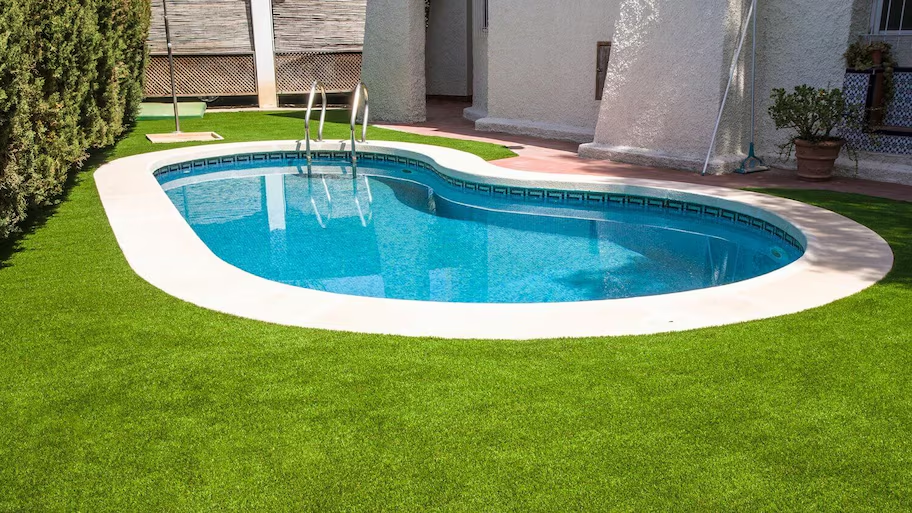Decking Maintenance and Longevity
Pavers, Synthetic Turf, Pergolas, Decking, Firepits, BBQ’s, Lighting and more…
Welcome to Lifetime Outdoor Living – transforming your outdoor areas into beautiful, functional extensions of your home.

Our Approach to Outdoor Excellence
From elegant paver driveways and inviting patios to lush turf, stylish decks, and integrated lighting, we specialize in designing and building beautiful outdoor environments for lasting enjoyment. Embark on transforming your space within a week!
Deck Lifespan Essentials
LIFESPAN FACTORS
Wood type and environmental exposure are key. Hardwoods often last longer than softwoods. Consider how often you use your deck. More use can mean more wear.
Local weather also affects lifespan. Decks in drier climates may last longer than those in wet areas, due to fewer problems with insects.
MATERIAL DURABILITY
Choose deck material with resistance to rot and insects for longevity. Look at hardness ratings; harder materials tend to endure better.
Materials with UV protection are smart choices, too. They can prevent fading and maintain strength over time.
CLIMATE IMPACT
Be aware that decks expand and contract with temperature changes. In extreme heat or cold, this is crucial to remember.
In rainy climates, moisture damage is a risk for your deck’s health. Choose materials designed to withstand such conditions for the best results.
USAGE EFFECTS
Heavy furniture might strain your deck’s structure over time. Try limiting these items if possible.
Discourage activities that scratch surfaces, like skateboarding on the deck area. Also, grill mats are useful when barbecuing—they protect against heat and grease damage.
Wood Deck Longevity
LIFESPAN EXPECTANCY
The life of your wood deck hinges on several factors. Common decking materials each have their own average lifespans. It’s important to set realistic expectations for how long your deck will last, taking into account the level of maintenance you’re committed to providing.
You might notice boards warping or color fading over time. These are signs that your deck is aging and may soon need replacement. By recognizing these early, you can plan ahead for upkeep or a new installation.
MAINTENANCE IMPACT
Regular cleaning does more than keep your deck looking good—it prevents damage from setting in deep within the wood fibers. Timely repairs like fixing loose boards or splintered areas help avoid larger issues down the line.
Here’s why proactive maintenance matters:
- Prevents costly replacements: Catching problems early means less extensive work later.
- Extends lifespan: Your diligence could add years to your deck’s usability.
- Saves money: Regular upkeep helps dodge hefty repair bills due to neglect.
Routine Deck Upkeep
ANNUAL INSPECTIONS
To ensure your deck’s longevity, perform annual inspections. Look for loose boards or nails that stick out. This prevents accidents and further damage. Each year, also check for rot or insect harm. Catching these issues early can save you time and money.
Make sure railings and stairs are stable. These areas bear more weight and use than other parts of your deck.
CLEANING PRACTICES
Regular sweeping keeps your wood looking new. It removes debris that might scratch the surface over time. Always choose cleaners suitable for your decking material to avoid any damage.
Be cautious with power washing; it can be harsh on wood if done incorrectly.
SEALANT APPLICATION
Applying sealant every two years is key to protecting against moisture and sun damage. Pick a sealant that works well with the type of deck you have.
Always follow the manufacturer’s instructions when applying sealant to get the best protection for your investment.
Composite vs Wood Decking
COMPOSITE BENEFITS
Composite decking offers you a long-term solution for your outdoor space. It stands strong against the sun, resisting fading and staining remarkably well. You’ll find it keeps its color and finish longer than wood does. Plus, this type of decking material demands less upkeep. Unlike traditional wood decks, composites don’t need sanding or sealing.
The lifespan of composite materials often outlasts that of wood. They can last for decades with minimal care. This means more time enjoying your deck and less time maintaining it.
WOOD CHALLENGES
However, wood decking has its drawbacks. It’s prone to rotting, insect damage, and warping over time. These issues mean you’ll be investing in more frequent maintenance to keep the deck safe and looking good.
Be prepared to replace parts of your wooden deck more often than with composite options. The natural elements can take a toll on even the best-treated lumber.
MATERIAL BREAKDOWN
It’s crucial to spot early signs of breakdown in your decking material—discoloration or splintering are red flags not to ignore in wooden decks.
Look out for these signals:
Color changes
Splinters forming
Loose boards
Should you notice any structural weakness due to material degradation, act fast! Prompt attention could save you from larger repairs down the line.
Maximizing Deck Longevity
REGULAR MAINTENANCE
To keep your deck in top shape, regular cleaning is essential. Dirt and debris can lead to surface damage if not removed. Use a gentle brush and appropriate cleaner to protect the material, whether it’s wood or composite from the previous section.
You should also inspect your deck often. Look for loose nails or screws that need tightening. It’s best to replace damaged boards quickly. This prevents further harm and maintains your deck’s integrity.
STRUCTURAL INTEGRITY
A well-built deck stands firm over time. Make sure proper installation methods were used at the start. This ensures lasting stability and safety for everyone who enjoys it.
Be vigilant about checking load-bearing elements like joists and beams regularly for signs of stress or failure—especially after harsh weather events. If you find any issues, act fast! Prompt repairs prevent more severe problems down the road.
MOLD PREVENTION
Mold thrives in damp areas with little air movement. To stop mold growth, ensure good airflow under and around your decking. Here are quick tips:
- Elevate planters to avoid trapped moisture.
- Keep spaces between boards clear of debris.
Spills happen but tackle them swiftly to stop mold from taking hold on surfaces. Also, trim back plants near the deck. More sunlight means less moisture—and less chance for mold.
Preventative Measures
PROTECTIVE SEALANTS
You know that sealants are key to keeping your deck in top shape. Choose products with waterproofing and UV protection. This helps guard wood against rain and sun damage. Remember, it’s not a one-time job. You need to reapply sealants as the product suggests.
Look for signs of wear like cracks or peeling during regular checks. This keeps your deck safe from moisture and decay.
JOIST TAPE USE
When building your deck, don’t overlook joist tape. It acts as a moisture barrier, crucial for longevity. Apply this tape on joists where they meet the decking boards.
Over time, check the tape for damage or wear. Replace it if you find any issues to prevent rot at these critical spots.
SUBSTRUCTURE CARE
The strength of your deck lies beneath — in its substructure made up of beams and posts. Inspect these parts often for any sign of trouble like cracking or soft spots which can suggest rotting or insect damage.
If you spot weakness, act fast to reinforce these areas before problems spread further ensuring that the entire decking system remains stable and secure over time.
Professional vs DIY Maintenance
CLEANING BENEFITS
A clean deck not only looks great, but it also lasts longer. Regular cleaning prevents dirt and debris from causing surface wear or even decay. By keeping your deck spotless, you avoid the dangers of slippery surfaces caused by algae or mildew.
Remember that a thorough scrub can do wonders for your deck’s longevity. Professionals often use specialized tools and solutions to ensure every nook is pristine without damaging the wood.
MISTAKES TO AVOID
Small repairs might seem insignificant, but they can escalate quickly if ignored. Address these issues promptly to save time and money in the long run. It’s crucial you choose the right products for maintenance; harsh chemicals can harm more than help.
Also, water should never pool around your decking area. If you notice drainage problems, act fast! This will protect the structural integrity of your deck and prevent potential hazards.
SEALANT DIFFERENCES
Sealants are vital for protecting your deck from moisture and weather damage. You’ll find oil-based sealants penetrate deeply providing robust protection. Water-based options are easier to clean up and less odorous during application.
Your choice may depend on local climate conditions or personal preference for environmental sustainability—some eco-friendly sealants perform just as well without harming nature.
Upgrading for Durability
LIFESPAN EXTENSION
To keep your deck in prime condition, establish a care routine specific to its needs. Regular cleaning and inspection can go a long way toward preventing larger issues down the road. Instead of waiting for problems to demand an entire deck overhaul, consider upgrading components as needed over time.
Stay on the lookout for new methods or products that could enhance your deck’s lifespan even further. Innovations in decking material can offer improved resistance to elements or easier maintenance requirements.
Closing Thoughts
Deck maintenance is your ticket to enjoying that outdoor space for years to come. Whether you’ve gone with the natural elegance of wood or the resilience of composite, remember that a little effort goes a long way. Keep up with regular cleanings, stay vigilant for signs of wear, and don’t shy away from calling in the pros when heavy lifting is needed. It’s all about protecting your investment and keeping those backyard barbecues and serene morning coffees on the agenda.
Now, get out there and show your deck some love. Give it a once-over, make a plan for upkeep, or consider that upgrade you’ve been dreaming about. Your deck’s longevity is in your hands, and it’s time to ensure it stands strong against the test of time. Got questions or need advice? Reach out—we’re here to help you keep your deck at its best.
Our Success Model in Steps
Lifetime Outdoor Living specializes in creating exceptional, long-lasting outdoor paving solutions, customizing each project to our clients’ specific desires and requirements. Our commitment to quality and customer satisfaction drives our process from the initial consultation through to the installation and beyond, ensuring every space we transform becomes a testament to our dedication and expertise.
Get Free Estimate
Fill the form & we will call back!
Why LifeTime OutdoorLiving
Free Estimate
100% Free Estimate
Free Consultation
100% Free Consultation
Premium Materials and Customization
We pride ourselves on using only premium-grade materials
Custom 0% Financing Options
At Lifetime Outdoor Living, we’re committed to ensuring that nothing stands between you and the outdoor living space of your dreams—not even budget constraints. That’s why we’re proud to offer a variety of affordable financing options designed to fit your unique needs, including our standout “0% Interest” financing plan. This special offer enables you to embark on your project without the worry of interest accumulation, making it easier and more affordable to start enjoying your new outdoor space sooner rather than later.
From Anaheim to Laguna Beach
We serve in Every City in Orange County, CA
Aliso Viejo
Anaheim
Buena Park
Costa Mesa
Cypress
Dana Point
Fountain Valley
Fullerton
Garden Grove
Huntington Beach
Irvine
La Habra
La Palma
Laguna Beach
Laguna Hills
Laguna Niguel
Laguna Woods
Lake Forest
Los Alamitos
Mission Viejo
Newport Beach
Orange
Placentia
Rancho Santa Margarita
San Clemente
San Juan Capistrano
Santa Ana
Seal Beach
Stanton
Tustin
Villa Park
Westminster
Yorba Linda
